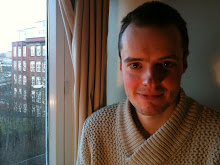The most important thing is to look at the painting... Not in order to understand or to know it, but to feel something.
- Francis Bacon

As a human, I am interested in humans. I can't help it. It's probably a survival trait. I am also interested in art and find humanity in art appealing. I prefer art that represents the human form as I find it the most resonant image – the one to which I repond the most strongly. It is a sure sign of bad sculpture if you find the horse more inspiring than the rider. At the beginning of the last century there was a move away from the human figure in painting. One exception to this was Francis Bacon.
Many of us have a romantic notion, almost an ideal, of the lonely artist struggling in his garret, tortured by inner demons and prone to passionate outbursts. Francis Bacon satisfied all of these criteria. He drank and he gambled. He destroyed many of his own paintings, often by putting his foot through the canvas. His tragic love life (in 1971 his lover, George Dyer, committed suicide the night before one of his exhibitions) fed into his work, although he always denied that his work was personal in nature.
Bacon was never formally taught art but he was widely read and visited art galleries regularly. For a couple of years he worked as a decorator and furniture designer but abandoned this in 1931. As an untrained painter he let his intuition guide his work and would move paint at random on the canvas until he found the forms that expressed his intangible ideas. He sometimes used house paints and worked on the 'wrong' side of the canvas. All of this gave him his unique style: twisted human figures that wiggle and seeth on the starkly coloured backgrounds.
The invention of photography was seen as a challenge by many painters. Why paint portraits and landscapes when there is a machine that can do the same thing cheaper, faster and more accurately? This helped fuel a move towards abstraction and a rejection of figurative art. Bacon was one of the first artists to embrace the photograph as an inspiration for his work. He collected photographs and images, which his mind fused together in his painting. Eadweard Muybridge's photographs of naked wrestlers became lovers entwined on a bed. In his 'Pope' paintings the head of Velazquez's pope is replaced by a screaming woman from Eisenstein's Battleship Potemkin. At a time when modernism was leading many artists away from the human body and into stripped down forms, Bacon painted figures that were unquestionably human and richer for it.
Whether or not you like his work, Francis Bacon should be admired as an artist who embraced the age of photography and created his own unique style. By the 1960's he was hailed as the greatest living painter and, when he died in 1992, he left behind a body of work that reminds us that great art can still be both original and human.

No comments:
Post a Comment